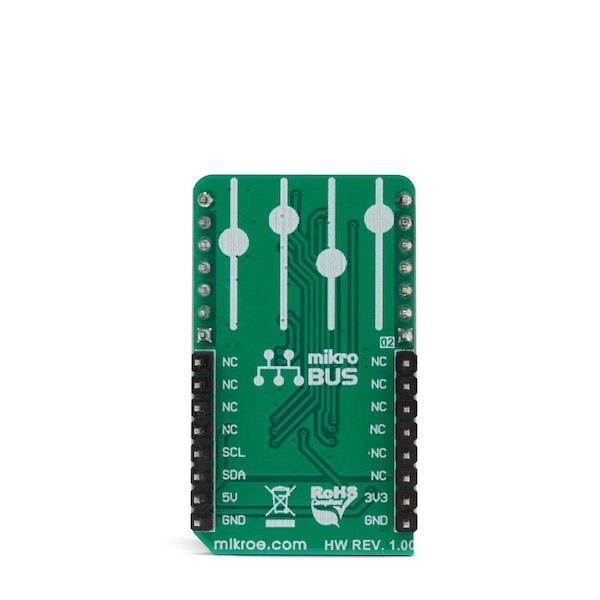EVC Click is a six-channel digital volume controller, equipped with an integrated electronic volume control circuit, which can be controlled over the I2C interface. The PT2258 IC offers six individual input channels, each with the attenuation range between 0 and -79dB, in 1dB steps. This chip requires a minimum number of external components, simplifying its implementation in a wide range of modern audio application. As an audio circuit, EVC Click features very low noise and high Signal to Noise ratio (SNR) of more than 100dB. Low Total Harmonic Distortion (THD) of 0.005% ensures absolute sound clarity.
EVC Click is supported by a mikroSDK compliant library, which includes functions that simplify software development.
Equipped with six digitally controlled attenuators, featuring high channel separation, extremely low noise, great SNR ratio of more than 100dB, and low count of required external components.
The main component of the EVC Click is the PT2258, a six-channel electronic volume controller IC, by Princeton Technology Corp. This IC contains six digitally controlled audio attenuators, which can attenuate signals between 0dB and -79dB. Each channel can be individually controlled by two-byte commands, sent over the I2C interface.
Although digitally controlled, sound signals within the PT2258 remain in the analog domain. The PT2258 offers a very clear and undistorted sound. The Signal to Noise Ratio (SNR) of the PT2258 is specified to be 105dB (1V RMS at any input), while the Total Harmonic Distortion (THD) is only 0.005% (200mV RMS at any input). THD gets worse as the input signal rises: 2.8V RMS results in THD of 1%. The maximum input signal should stay below 2.8V, else too much audible distortion may appear at the output.
The Click board™ is equipped with two rows of standard 2.54mm (100 mil) headers. There are six pins at each row, allowing the inputs and the outputs to be easily interfaced with the existing multichannel equipment. This Click board™ should be connected on the signal path, either in front of the amplifier itself, or in front or behind other sound processing equipment (e.g. equalizer, delay, room correction…). That way, an optimal audio signal level will be ensured for the Click board™.
Each input/output pair runs through an internal attenuator, which provides up to -79dB of attenuation, in 1dB steps. Although it seems like a very high attenuation, using it with amplifiers with high gain values may lead to still hear the sound, even after the full attenuation. Therefore, the PT2258 features a MUTE function, that completely cuts the audio output.
To set attenuation of a certain level, two bytes must be consequently sent over the I2C interface. There are both -1dB step commands and -10dB step commands for each channel. To achieve the desired attenuation at the specific channel, two commands should be sent consequently: one for -10 dB attenuation, and one for -1 dB attenuation. These commands can be sent in any order. However, sending a single command or adding a MUTE command between two attenuation commands may lead to unpredictable results. This Click board™ is supported by a mikroSDK compliant library of functions, which greatly accelerate software development, by simplifying the software development.
The I2C peripheral address of the Click board™ can be set using two SMD jumpers, grouped under the I2C ADD label. First SMD jumper is labeled as C1, while the second jumper is labeled as C2. These jumpers are used to configure bits CODE1 and CODE2, allowing several different I2C addresses to be selected. These jumpers can be independently moved to either position, allowing to select the desired peripheral address. Please refer to the PT2258 datasheet for more information about configuring the I2C peripheral address.
The Click board™ uses the I2C interface for the communication. It can be interfaced with both 3.3V and 5V microcontrollers (MCUs) by simply switching the SMD jumper labeled as VCC COMM to a desired position. However, thePT2258 itself still requires 5V for its operation, since it requires a power supply voltage between 5V and 9V.
- Interface: I2C
- Compatibility: mikroBUS™
- Dimensions: 42.9 x 25.4mm
- Input Voltage: 3.3V or 5V
Comments
Looking for answers to technical questions?
We welcome your comments and suggestions below. However, if you are looking for solutions to technical questions please see our Technical Assistance page.
Customer Reviews
No reviews yet.



